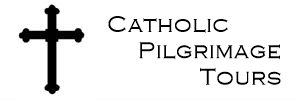Getting Ready for Your Catholic Pilgrimage Tour to Central Europe

Getting ready for physical activity:
Pilgrimages are oriented toward the spiritual and, by nature, engage the physical. Increase the amount of time you spend walking and moving around on foot, if you’re mostly sedentary. Take walks, get out in the sun and fresh air to accustom yourself to potentially longer days, and time on your feet during your pilgrimage. During your tour, have bottled water and snacks along to ensure you have energy when you need it.
Meticulously maintained streets and sidewalks in Central Europe make for trouble free mobility in most places. Rubber, not leather soles will have better traction, since rain may fall at any time of year, making surfaces slick.
Climate:
The climate of most of Central and Eastern Europe, is considered to be continental… cool and humid during summer, similar to the climate in states like Maine and Michigan, and compared to Western Europe, significantly colder winters, with snowfall a common occurrence.
For country by country specifics follow the links below:
Austria: https://www.climatestotravel.com/climate/austria
Czech Republic: https://www.climatestotravel.com/climate/czech-republic
Germany: https://www.climatestotravel.com/climate/germany
Hungary: https://www.climatestotravel.com/climate/hungary
Poland: https://www.climatestotravel.com/climate/poland
Money exchange:
Using a debit card at ATM’s is the easiest way to get Euro’s Central Europe, but you are likely to get better exchange rates by simply buying with a credit card. Exchange rates vary depending on the ATM machine owner and they all charge exchange fees. Avoid multiple ATM fees by withdrawing as few times as possible.
An ATM at a bank will give a better exchange rate than independently operated machines. If in doubt about where to go for Euro’s, check with your pilgrimage tour director.
It’s worthwhile to check with your credit card company to learn what their exchange rate is on purchases converted to Euro’s is prior to your tour. Let them know when you’ll be traveling so your card isn’t flagged for potential fraudulent use when charges from overseas start appearing.
Many travelers come with some Euros in hand from the USA or Canada. Getting Euros at most banks in cities is routine, in the USA and worldwide.
Cell phones:
Even though cell phones make it possible to communicate everywhere in the world, you are likely to incur big charges if you don’t let your carrier know you are heading out of the country. Set up a text and call package for while you’re overseas. If you don’t set up a plan including internet access, turn off cellular data in “settings”. The difference between turning off cellular data and turning on airplane mode is that airplane mode doesn’t allow calls or texts to come through while turning off cellular data does. When you’re hooked up to Wi-Fi is the only time you should access the internet or email. Be informed of what you can and can’t do with your phone so you don’t incur expensive roaming charges.
Telephones:
Approximately two weeks prior to your departure to Spain, we’ll send you a list of your hotels including their addresses and phone numbers where you may be reached.
To call Austria from the USA, just follow these simple dialing directions:
First dial 011, the U.S. exit code.
Next dial 43, the Austria country code.
Then dial the 1- to 4-digit area code. Including this area code, full Austrian phone numbers range from 5 to 13 digits.
To call Czech Republic from the USA, follow these dialing directions:
First dial 011 to exit the U.S. telephone system.
Now dial 420, which is the country code for the Czech Republic.
Next, dial the nine-digit local number.
To call Germany from the USA, follow these dialing directions:
First dial 011, the U.S. exit code.
Next dial 49, the country code for Germany, then the area code (2–5 digits)
Finally, dial the phone number (3–9 digits).
To call Hungary from the USA, follow these dialing directions:
First dial 011, the U.S. exit code.
Next dial 36, the country code for Hungary, then the area code (one or 2 digits)
Finally, dial the phone number
To call Poland from the USA, follow these dialing directions:
First, dial 011 to exit the U.S. telephone system.
Dial 48 next, which is the country code for Poland.
Finally, dial the local phone number, which will be 9 digits
Electrical considerations:
All countries in Central Europe runs on 220V current. Most cell phones / smart phones, computers and handheld devices now accept and immediately adapt to whatever voltage comes through wall current anywhere in the world. You do not need to purchase a voltage converter for them. You will, however, need an adapter compatible with European electrical outlets.
Other electrical equipment such as hair dryers, mini steam irons, etc. require an electrical converter. It is possible to conveniently purchase adapters as well as converters online at Amazon.com. Simply search for a “Universal Travel Adapter”, or “Universal Travel converter”, for full voltage conversion.
Most hotels in Central Europe have blow dryers in each room.
USA embassy / consular services in Austria:
U.S. Embassy Vienna
Boltzmanngasse 16
1090 Vienna, Austria
Phone: (+43-1) 31339-0
Fax: (+43-1) 310 06 82
USA embassy / consular services in Czech Republic:
U.S. Embassy Prague
Tržiště 15
118 01 Praha 1 – Malá Strana
Czech Republic
Tel: (+420) 257 022 000
USA embassy / consular services in Germany:
Königinstraße 5
80539 München / Munich
Federal Republic of Germany
Tel.: +49-89-2888-0
+Fax: +49-89-280-9998
USA embassy / consular services in Hungary:
U.S. Embassy Budapest
Szabadság tér 12
H-1054 Budapest, Hungary
Phone:(36-1) 475-4400
Fax: (36-1) 475-4248
USA embassy / consular services in Poland:
U.S. Embassy Warsaw
Aleje Ujazdowskie 29/31
00-540 Warsaw Poland
Tel.: +48 22 504 2000
Emergency:
112 is the European emergency number you can dial free of charge from fixed and mobile phones everywhere in the EU. It will get you straight through to the emergency services – police, ambulance, fire brigade.
Have additional questions?
Please look at our Travel Info page. Almost anything you want to know about traveling on a Pilgrimage Tour is covered there.
